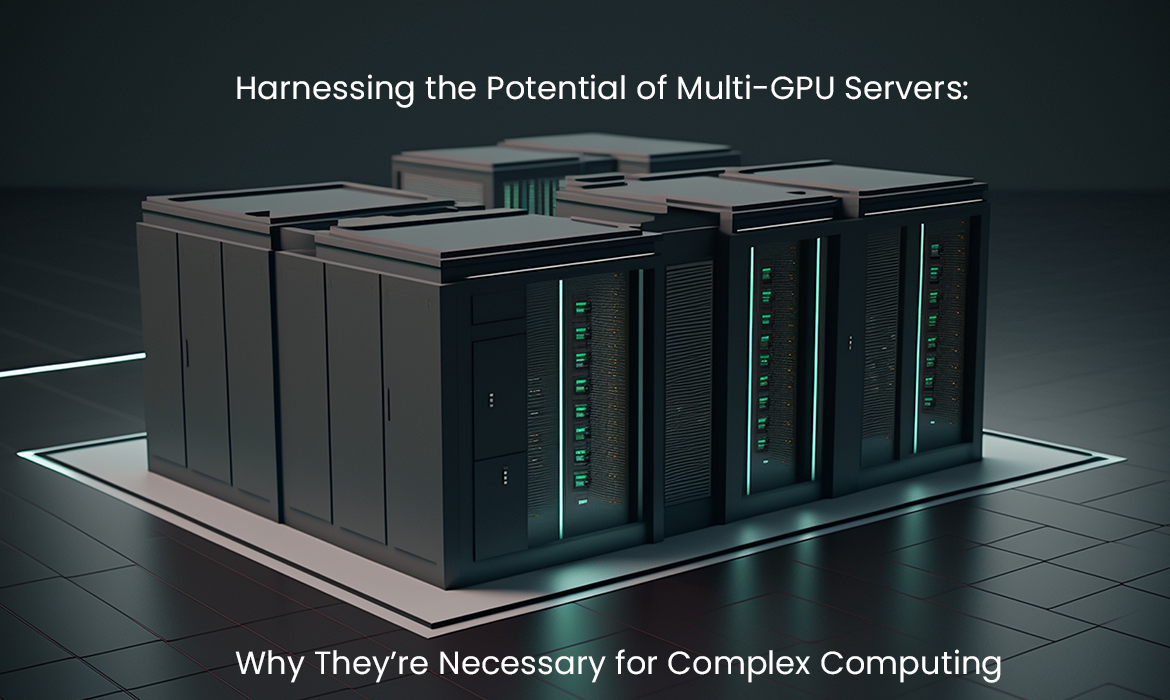Harnessing the Potential of Multi GPU Servers: Why They’re Necessary for Complex Computing
In the field of artificial intelligence, deep learning, and big data, computational requirements have surged, and standard single GPU-based systems cannot properly maintain a particular speed. For all those wanting high-performance computing (HPC), a multi GPU servers has now completely become a groundbreaking solution. By including numerous GPUs into a single server, multi-GPU servers are engineered to resolve the most challenging computing tasks, providing exceptional speed and processing power.
Even if you are involved in AI research, complex simulations, or advanced data processing, a multi-GPU server can knowingly boost your workflows. This article covers what makes multi-GPU servers so robust, their working, and necessity for high-performance computing (HPC) tasks.
Working of Multi GPU Servers?
A multi GPU servers includes various graphics cards that are generally installed in only one server unit. GPUs, mainly built to manage challenging graphics tasks, have discovered a new part in boosting computational tasks more than graphics, specifically in various fields such as AI and deep learning. Multi-GPU servers let all these graphics cards function together at the same time, distributing all the tasks across GPUs to boost computational speed.
This whole setup supports parallel processing, where complex tasks are divided and processed at the same time across numerous GPUs. This parallelization states that data can be easily processed with more speed as compared to a specific GPU could handle, leading to unexpectedly enhanced performance.
Advantages of a Multi-GPU Server
Increased Speed & Performance
The main benefit of multi-GPU servers is their proficiency to manage complex computational loads with more speed. For example, AI-based model training, which can take a lot of time on one GPU, can be easily done in very little time on any multi-GPU server. This speed is very important for organizations and researchers who want quick processing to make productive decisions or offer results quickly.
Flexibility & Scalability
A multi-GPU server provides superior scalability. As your demand increases or becomes more challenging, you can manage your server configuration by integrating more GPUs. This flexibility is mainly useful in development and research, where the computational needs might enhance over some time. With a multi-GPU setup, leveling up does not state that you have to purchase a new system; you can frequently extend the previous setup to add more GPUs.
Budget-Friendliness for Advanced Tasks
While multi-GPU servers are one of the best investments, they are budget-friendly for advanced tasks in the long term. Instead of buying different machines or paying for cloud computing, a specific multi-GPU server can manage high-level computational tasks under one system. This decreases hardware charges and the related costs of handling different systems, making it a perfect choice for organizations with constant computing requirements.
Best for Deep Learning, ML & AI
Multi-GPU servers are generally used for AI/ML and deep learning applications. Training advanced networks and performing scientific simulations need multi-GPU servers and extensive processing power to offer the required speed and productivity. With the help of GPU parallel processing, ML-based models can be fully trained in a few hours instead of days, boosting time-to-market and allowing quicker iterations for enhancements.
Productive for Data-Based Applications
More than AI, multi-GPU servers are beneficial for all types of applications that need processing huge amounts of information. These consist of various areas such as scientific research, machine learning modeling, graphic rendering, and many more. In data-based tasks, speed is most important, and multi-GPU configuration makes sure that data is simply processed rapidly without negotiating on quality or precision.
Use Cases of Multi-GPU Servers
Genomic Bioinformatics & Research
In various segments, such as bioinformatics, processing huge numbers of genomic data needs vast computational power. Multi-GPU are appropriate for various tasks like genetic analysis and others where speed and accuracy are crucial for diagnostics and research.
Scientific Simulations & Research
In the case of scientific research, simulations generally need huge computational power to precisely challenge systems, like weather patterns, molecular composition, or others. Multi-GPU servers allow researchers to replicate situations more precisely and in complete detail by boosting the computational tasks.
Realistic Data Processing in Finance
Financial institutions manage huge amounts of data in every single second, making realistic processing necessary for various activities such as risk management and algorithmic trading. A multi-GPU server can manage quick data processing and make sure that financial-based models are updated rapidly, offering a competitive advantage for investment-related corporations.
Autonomous Vehicle Development
Autonomous vehicle development depends mainly on algorithms of deep learning and quick data processing to encode sensor information and make rapid decisions. Multi-GPU servers can manage the load needed for training all these deep learning algorithms from different types of sensors, boosting growth in autonomous vehicle technology.
Selecting the Best Multi-GPU Provider
Server Specifications
Opt for robust GPUs such as NVIDIA’s H100, which are engineered for advanced computational tasks in machine learning and artificial intelligence.
Suitability with Software
Make sure that the server is suitable for the particular applications and software needed for your tasks.
Scalability Options
Select a service provider that provides scalability, letting you upgrade your server proficiency as your complex computational requirements elevate.
Constant Support
Scalable support is crucial for resolving problems that may occur and ensuring seamless server working.
Affordability
Assess the cost according to your budget and heavy workload, as multi-GPU servers are a permanent investment for advanced computing projects.
Conclusion
For both researchers and businesses managing high-performance computing (HPC) tasks, a multi-GPU server is fundamental. Its robust processing power, high scalability, and affordability allow quicker project working, which is necessary for enhancements in artificial intelligence, and data-powered fields.
When opting for trustworthy GPU plans, GPU4HOST provides unmatched service and skills customized to advanced computing requirements. With constant customer support, and reliable choices, GPU4HOST makes sure that you have the powerful architecture and guidance to boost your computational proficiencies. Select GPU4HOST to harness the full power of multi-GPU servers and remain in the lead in today’s quickly growing digital landscape.


